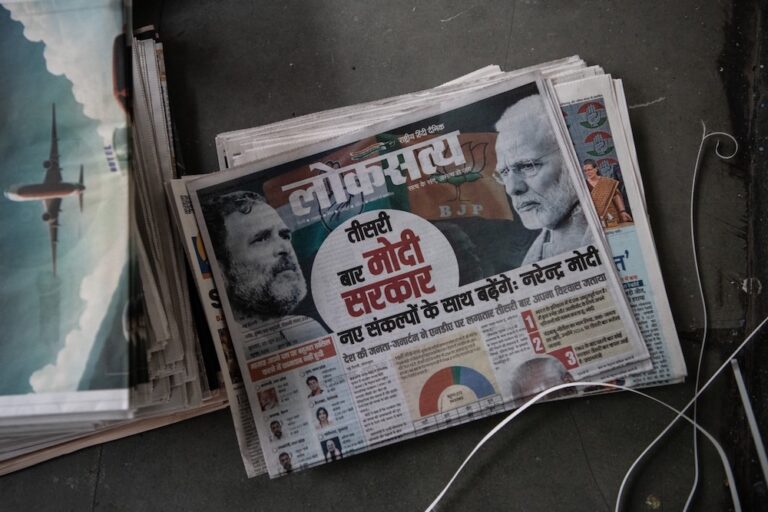India's healthy and lively debate about digital freedom stands as a beacon of hope in the face of some of its more disturbing laws. But the laws will need to change, if India is to be a country that stands for Internet freedom, says Index on Censorship.
(Index on Censorship/IFEX) – 22 January 2013 – In the aftermath of an Index on Censorship debate in New Delhi, Kirsty Hughes, Chief Executive of Index on Censorship, says India’s web users are standing at a crossroads.
If debate is a sign of a positive environment for internet freedom, then India scores highly. From debates in parliament, and panel discussions (including Index’s own recent event) to newspaper editorials, blogs and tweets on the rights and wrongs of internet freedom, controls on the web, and India’s position in the international debate, there is no shortage of voices and views.
India has around 120 million web users – a large number but still only about 10 per cent of the country’s population. As cheaper smart phones enable millions more to access the net on their mobiles, India’s net savvy population is set to soar in the next few years. But what sort of online environment they will find is open to question – and to wide debate.
India has some very broad laws that could apply to a wide range of online speech, comment and criticism. These laws have been so far rather randomly applied. But the cases that have arisen – from individuals criticising politicians by email, Facebook or Twitter to some of the big web companies such as Google and Facebook (both facing numerous takedown requests and court cases in India) – show just why India needs to look at limiting both the range of some of its net laws, and to stop these laws criminalising a range of speech.
In 2012, there was widespread outcry in India when two women were arrested for complaining on Facebook about the disruption caused by the funeral of Bal Thackeray, leader of the right wing Hindu party, Shiv Sena. They were arrested under the infamous section 66A of India’s IT Act (2008) which criminalises “grossly offensive” and “menacing” messages sent by electronic means, but also “false” messages sent to cheat, deceive, mislead or annoy, taking online censorship beyond offline laws.
India’s telecom minister Kapil Sibal spoke out against the arrests. And as part of the fallout, guidelines were announced that in future any such charges could only be brought by senior police. But how effective such a restriction might be was challenged, with a Times of India editorial suggesting “rampant political interference in law enforcement is itself a burning issue . . . so to argue that senior police officers will always resist mob pressure or political diktats isn’t persuasive.”
Other parts of the IT Act (2008) are also causing a chilling atmosphere in India’s cyber sphere – with new regulations introduced in 2011 obliging internet service providers to take down content within 36 hours of a complaint (whether an individual, organisation, government body or anyone else) or face prosecution. The law covers a sweeping range of grounds for complaint, including “grossly harmful”, “harassing, “blasphemous” and more. It also is confused on liability – holding intermediaries large and small responsible for content on websites and platforms.
One of India’s leading policy centres on digital issues, the Centre for Internet and Society, decided to test how this 36-hour takedown rule could result in censorship of innocuous and legal content on web sites. They sent complaints to four main search engines across a range of content – and as a result got thousands of innocuous posts removed; a censor’s dream outcome.
Despite a debate in parliament calling for repeal of the 2011 rules, for now they remain.
Some observers suggest the Indian government is in catch-up mode, not fully understanding the reach or nature of social media or how to deal with the international range and speed of the web today – something plenty of other governments around the world are showing some confusion about. Some think the lively debate on net freedom in India reflects the voice and demands of the growing Indian middle class. But whether those demands remain pro-freedom is yet to be seen as internet penetration grows apace.
There are some other encouraging signs. While many in India are not keen at US dominance of key parts of internet regulation, there was concern from business and civil society ahead of the International Telecommunications Union summit in December 2012, when the Indian government looked like it might advocate some form of top down control of the web as an alternative. In the event, India, like the EU and US, did not go along with Russia, China and others keen to include net governance into the ITU’s remit.
India is going to be an increasingly influential voice in global internet debates – with its rapidly growing number of netizens and its increasing clout more widely in a multipolar world.
Its healthy and lively debate about digital freedom stands as a beacon of hope in the face of some of its more disturbing laws. But the laws will need to change, if India is to be a country that stands for internet freedom.


